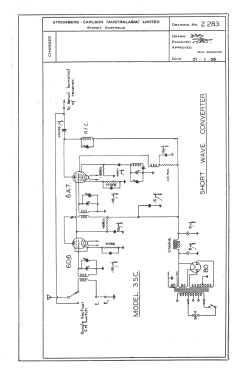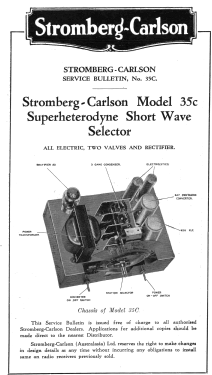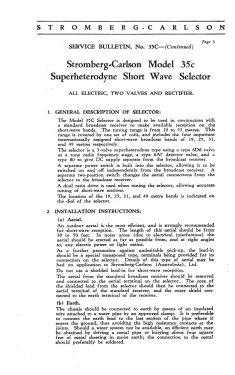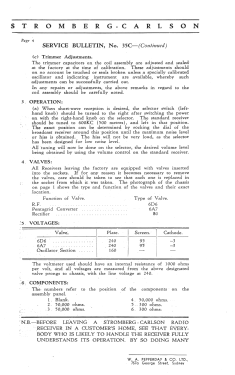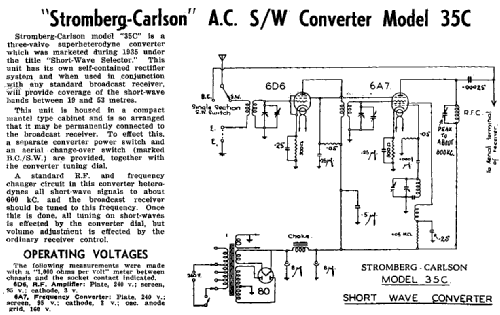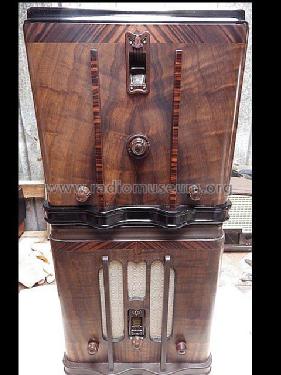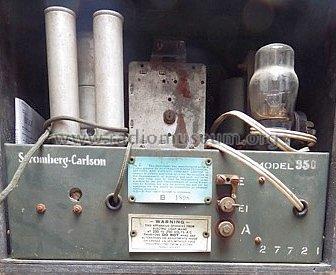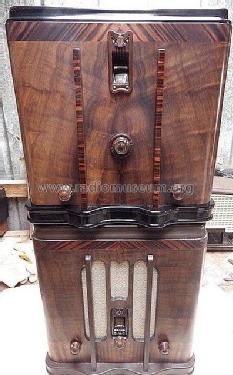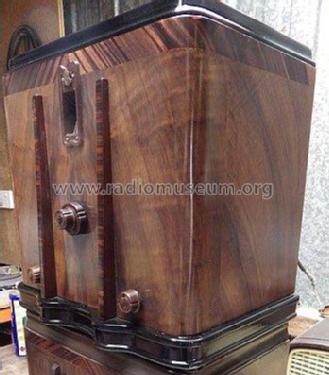Short-Wave Selector 35C
Stromberg-Carlson (Australasia) Pty. Ltd. Sydney
- País
- Australia
- Fabricante / Marca
- Stromberg-Carlson (Australasia) Pty. Ltd. Sydney
- Año
- 1935
- Categoría
- Conversor o Adaptador de frecuencia
- Radiomuseum.org ID
- 170946
Haga clic en la miniatura esquemática para solicitarlo como documento gratuito.
- Numero de valvulas
- 3
- Principio principal
- Superheterodino con paso previo de RF; ZF/IF 600 kHz
- Número de circuitos sintonía
- 4 Circuíto(s) AM
- Gama de ondas
- Onda Corta solamente
- Tensión de funcionamiento
- Red: Corriente alterna (CA, Inglés = AC) / 240 Volt
- Altavoz
- - - No hay salida de sonido.
- Material
- Madera
- de Radiomuseum.org
- Modelo: Short-Wave Selector 35C - Stromberg-Carlson Australasia
- Forma
- Sobremesa de cualquier forma, detalles no conocidos.
- Anotaciones
-
The Model 35C Selector is designed to be used in conjunction with a standard broadcast receiver to make available reception on the shortwave bands. The tuning range is from 19 to 53 metres.
This range is covered by one set of coils and includes the four important internationally assigned shortwave broadcast bands of 19, 25, 31, and 49 metres respectively.The selector is a 3-valve superheterodyne type using a type 6D6 valve as a tune radio frequency stage, a type 6A7 detector valve, and a type 80 to give DC supply separate from the broadcast receiver.
A separate power switch is built into the selector, allowing it to be switched on and off independently from the broadcast receiver. A separate two-position switch changes the aerial connections from the selector to the broadcast receiver.
A dual ratio drive is used when tuning the selector, allowing accurate tuning of short-wave stations.
The location of the 19, 25, 31, and 49 metre bands are indicated on the dial of the selector.
Operation:
When shortwave reception is desired, the selector switch (lefthand knob) should be turned to the right after switching the power on with the right-hand knob on the selector.
The standard receiver should be tuned to 600KC (500 metres) and left in that position.The exact position can be determined by rocking the dial of the broadcast receiver around this position until the maximum noise level or hiss is obtained. The hiss will not be very loud, as the selector has been designed for a low noise level.
All tuning will now be done on the selector, the desired volume level on the standard receiver.
- Precio durante el primer año
- 19.00 Aus£
- Documentación / Esquemas (1)
- Radio Trade Annual of Australia (Radio Trade Annual 1939 P347.)
- Documentación / Esquemas (2)
- - - Manufacturers Literature (Service Bulletin No. 35C)
- Autor
- Modelo creado por Stuart Irwin. Ver en "Modificar Ficha" los participantes posteriores.
- Otros modelos
-
Donde encontrará 359 modelos, 178 con imágenes y 185 con esquemas.
Ir al listado general de Stromberg-Carlson (Australasia) Pty. Ltd. Sydney
